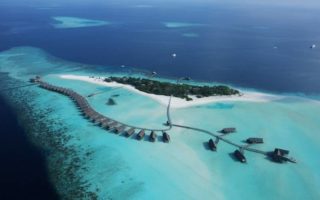The history of this tiny Asian nation reads like a romantic folklore legend, full of epic battles, heroic struggles, and culturally shifting events that culminate in the creation of something unexpected. Vietnam continues to reinvent itself. With 65% of its population under the age of 25, this is not hard to do. Even though Vietnam is rather small in size due to its long and narrow shape, 89 million inhabitants call this country home. From a war-torn history to a future full of prosperity, courtesy of foreign investments, Vietnam continues to be one of the most interesting places to visit in Southeast Asia. Here’s a look at the top ten sights in Vietnam that every tourist should visit.
Imperial City in Hue
- Built in 1804 by Emperor Gia Long with an army of 10,000 workers.
- Surrounded by a moat and thick walls, two meters in thickness.
- Forbidden Purple City inside the walls was reserved for the royal family.
- World Heritage Site since 1993, attracting tourists worldwide.
- Cultural significance with thrones, shrines, and tombs of royalty.

This sprawling compound of Asian architecture was built by an army of ten thousand workers in 1804 at the request of Emperor Gia Long. A moat and walls, two meters thick, surround the palatial compound. Inside the walls are thrones, shrines, tombs, and accommodations fit for royalty. A smaller compound, reinforced with even more walls, known as the Forbidden Purple City, sits within the confines of the first set of walls. The Purple City was reserved for the emperor’s family and his trusted delegates. The Imperial City in Hue was designated a World Heritage Site in 1993 and is one of many such sites of World Heritage distinction in the country.
- Suggested to Read: Best Time to Visit in Vietnam
Ho Chi Minh City (Saigon)
- Formerly known as Saigon, it was renamed after the Vietnam War in 1976.
- A vibrant city with a mix of modern skyscrapers and French Colonial architecture.
- Home to over 8 million people, it’s the largest city in Vietnam.
- Famous for its nightlife, bustling markets, and dining scene.
- Tourist attractions include Notre Dame Cathedral and Ben Thanh Market.

Ho Chi Minh City (formerly Saigon) is where old Vietnam meets new Vietnam. It is the Vietnamese equivalent of New York City – a city that never sleeps. New high-rise buildings and skyscrapers share space with traditional structures of historical and cultural significance. Ho Chi Minh City features a surprising amount of French Colonial architecture, such as the Notre Dame Cathedral and the Hotel de Ville. Shopping, entertainment, cultural tours, and a thriving nightlife make Ho Chi Minh City the place to see and be seen in Vietnam.
Floating Markets On The Mekong Delta
- A unique shopping experience, with boats selling produce and goods.
- Located in southern Vietnam, especially around Can Tho and Ben Tre.
- Boats navigate winding rivers to deliver products to buyers along the shore.
- Most active in the morning, particularly from dawn till midday.
- Cultural heritage of the region, reflecting traditional ways of life.

The Mekong Delta region of Vietnam appears untouched by the progress seen in large cities. Here, locals still make their livings by working the land, growing what they eat, and selling the excess. They peddle their wares (usually produce or other food items) via small boats that float along a series of winding tributaries. Shoppers motion to the boat drivers to approach the shore so they can make their purchases. It is truly a unique shopping experience that no one traveling to Vietnam should miss.
Hanoi
- Capital of Vietnam, known for its centuries-old architecture and culture.
- Attractions include the Temple of Literature, Hoan Kiem Lake, and the One Pillar Pagoda.
- A blend of French Colonial influence and traditional Vietnamese architecture.
- Rich history, with sites related to the French colonial period and the Vietnam War.
- Famous for its food, especially dishes like Pho and Bun Cha.

A trip to Vietnam’s capital city of Hanoi feels like a vacation in itself, due to the number of attractions to see. Some must-see sights in Hanoi include the Temple of Literature, the Opera House, Ba Dinh Square, Hoan Kiem Lake, and the One Pillar Pagoda.
- Also Read: Places to Visit in Sri Lanka
Beaches Of Vietnam
- Over 3,000 kilometers of coastline with a variety of beach destinations.
- Popular beaches include Da Nang, Nha Trang, and Phu Quoc.
- Phu Quoc island is known for stunning sunsets over the ocean.
- Less-developed beaches like Con Dao are ideal for relaxation.
- Vietnamese beaches cater to both tourists and locals, with varying levels of crowding.

Due to one entire side of the country being bordered by water, there are miles of beaches in Vietnam. Some are tourist-oriented, while others are frequented only by locals. There are also secluded beaches that have yet to be explored. So, wherever you go in Vietnam, chances are there’s a beach nearby. However, if watching the sunset on a Vietnamese beach is on your list, you’ll have to do it on Phu Quoc, Vietnam’s southernmost beach. It’s said to be the only place in the entire country where you can see the sunset over the ocean.
The Caves of Halong Bay
- Located in northeastern Vietnam, four hours from Hanoi.
- Over 2,000 limestone islands in the bay, many with caves and grottoes.
- Accessible caves include Sung Sot (Surprise Cave) and Dau Go Cave.
- A UNESCO World Heritage Site, recognized for its natural beauty.
- A popular tourist activity includes boat tours and cave exploration.

Halong Bay, located four hours east of Hanoi, is another one of Vietnam’s World Heritage Sites. The bay contains over 2,000 limestone islands and a network of numerous caves. Twenty of them are open to visitors and include some of great historical significance.
Ba Na-Nui Chua Nature Reserve
- Located on Mount Ba Na, which rises almost 1,500 meters above sea level.
- A rich biodiversity with over 60 species of mammals and 180 species of birds.
- Home to rare plants with more than 500 varieties of native species.
- Accessible by the Ba Na cable car, one of the longest in the world.
- A prime spot for nature enthusiasts and eco-tourism in Vietnam.

Situated at the top of Mount Ba Na (which rises to a height of almost 1,500 meters), the Ba Na-Nui Chua Nature Reserve is one of the most unique nature areas in the world. It is home to sixty types of mammals, nearly 180 species of birds, 17 species of reptiles, and over 500 varieties of native Vietnamese plants.
My Son Holy Land
- An ancient Champa site, dating back to the 2nd century.
- Located in central Vietnam, near Hoi An.
- UNESCO World Heritage Site, representing Champa culture and architecture.
- Temples and ruins dedicated to Hindu deities, showcasing unique brick architecture.
- A spiritual and historical center, once a religious capital of the Champa Kingdom.

My Son Holy Land is an ancient spot of historical, religious, and cultural significance in Vietnam, and it is also another one of the country’s World Heritage Sites. It was once home to some of Vietnam’s original inhabitants – the Champa people. Dating back to the 2nd century, the site contains many ruins of original buildings, temples, and altars of the Champa civilization.
Tam Dao Tourist Area
- Located in northern Vietnam, known for its cool, temperate climate year-round.
- Popular for eco-tourism, hiking, and exploring local culture.
- Developed by the French into a tourism destination in the 19th century.
- Known for its scenic beauty, surrounded by mountains and forests.
- A retreat from the heat of Vietnam’s lowland areas, perfect for relaxation.

The Tam Dao Tourist Area, located in northern Vietnam, is a popular vacation spot for tourists due to its temperate climate year-round. It is a quaint village-like area that was transformed into a tourism hotspot by the French in the last century. Shopping, dining, dancing, and enjoying the cool climate are some of the amenities tourists can enjoy in this picturesque region.
- Must Read: BEST Places to Visit in Dubai
Ban Gioc Waterfall
- Located in the Trung Khanh District, near the border with China.
- One of the largest waterfalls in Vietnam, with multi-tiered cascades.
- Surrounded by lush greenery and nestled in a quiet village setting.
- Hailed as the most beautiful waterfall in Vietnam.
- Accessible by boat or by hiking in the surrounding area.

The Ban Gioc Waterfall, located in the Trung Khanh District of Vietnam, is a multi-tiered waterfall on the border with China. The waterfall is hailed as the most beautiful in the entire country. It is nestled between green mountains and lush plant life, in the midst of quiet village communities.
Travel Tips:
- Tap water in Vietnam is not safe to drink so make sure you have plenty of bottled water when you go.
- Always ask permission before taking photographs. This is especially important in rural, minority areas.
- Dial up Internet is widely used in Vietnam so prepare for a slower connection than you are used to, if you plan to utilize Internet services while in the country.


